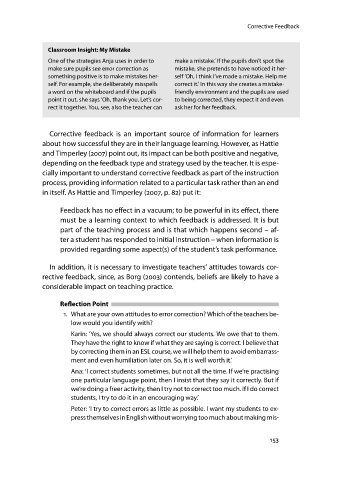Page 153 - Teaching English at Primary Level: From Theory into the Classroom
P. 153
Corrective Feedback
Classroom Insight: My Mistake
One of the strategies Anja uses in order to make a mistake.’ If the pupils don’t spot the
make sure pupils see error correction as mistake, she pretends to have noticed it her-
something positive is to make mistakes her- self ‘Oh, I think I’ve made a mistake. Help me
self. For example, she deliberately misspells correctit.’Inthisway shecreates amistake-
a word on the whiteboard and if the pupils friendly environment and the pupils are used
pointitout,she says ‘Oh, thankyou.Let’s cor- to being corrected, they expect it and even
rect it together. You, see, also the teacher can ask her for her feedback.
Corrective feedback is an important source of information for learners
about how successful they are in their language learning. However, as Hattie
and Timperley (2007) point out, its impact can be both positive and negative,
depending on the feedback type and strategy used by the teacher. It is espe-
cially important to understand corrective feedback as part of the instruction
process, providing information related to a particular task rather than an end
in itself.AsHattie and Timperley (2007,p.82) putit:
Feedback has no effect in a vacuum; to be powerful in its effect, there
must be a learning context to which feedback is addressed. It is but
part of the teaching process and is that which happens second – af-
ter a student has responded to initial instruction – when information is
provided regarding some aspect(s) of the student’s task performance.
In addition, it is necessary to investigate teachers’ attitudes towards cor-
rective feedback, since, as Borg (2003) contends, beliefs are likely to have a
considerable impact on teaching practice.
Reflection Point
1. What are your own attitudes to error correction? Which of the teachers be-
low would you identify with?
Karin: ‘Yes, we should always correct our students. We owe that to them.
They have the right to know if what they are saying is correct. I believe that
by correcting them in an ESL course, we will help them to avoid embarrass-
ment and even humiliation later on. So, it is well worth it.’
Ana: ‘I correct students sometimes, but not all the time. If we’re practising
one particular language point, then I insist that they say it correctly. But if
we’re doing a freer activity, then I try not to correct too much. If I do correct
students, I try to do it in an encouraging way.’
Peter: ‘I try to correct errors as little as possible. I want my students to ex-
pressthemselvesinEnglishwithoutworryingtoomuchaboutmakingmis-
153

